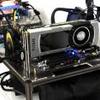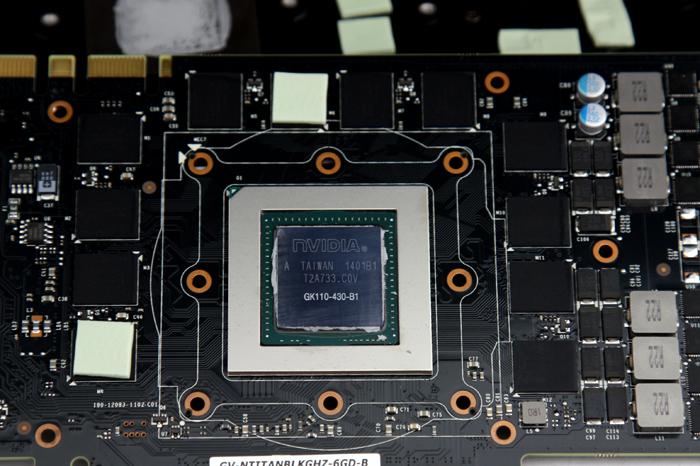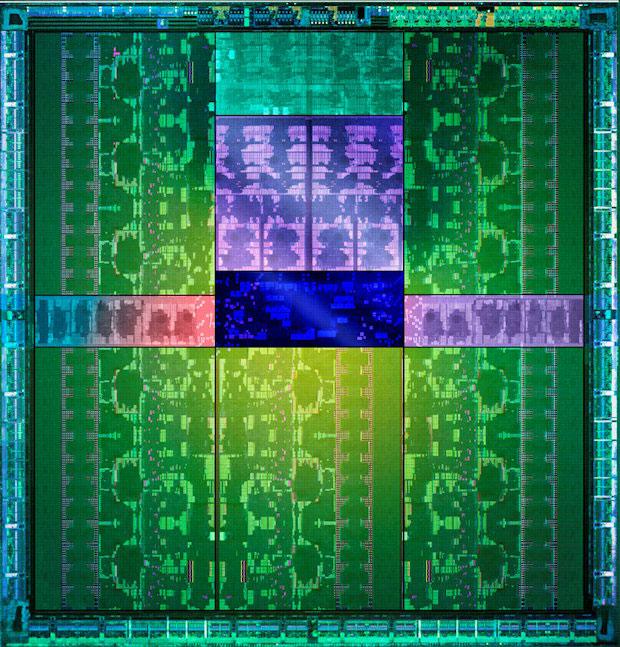Kepler GK110 Revision B Graphics Architecture
Technology & Specifications (Reference)
These charts tend to get a little repetitive as the GPUs are all based on the same silicon and architecture, but here we go. The GeForce GTX Titan Black is based on fully enabled GK110 Kepler GPU architecture, the Titan Black uses the revision B1 of GK110, two of them in fact. Each chip is big in size and based on the 28 nm fabrication node.
But when I say big I am not joking as it has 7.1 Billion transistors tucked away in a 45 mm × 45 mm 2397-pin S-FCBGA chip. That's a 561 mm² die size. GeForce GTX Titan Black now comes with an impressive 2880 CUDA (shader) cores and has 7100 Million transistors. That shader amount is amongst the biggest differentials together with ROP and TMU count:
- GeForce GTX 780 has 2304 shader processors and 3 GB of graphics memory.
- GeForce GTX Titan has 2688 shader processors and 6 GB of graphics memory.
- GeForce GTX 780 Ti has 2880 shader processors and 3 GB of graphics memory.
- GeForce GTX Titan Black has 2880 shader processors and 6 GB of graphics memory.
- GeForce GTX Titan Z has 2x2880 shader processors and 2x6 GB of graphics memory.
The product is obviously PCI-Express 3.0 ready and has a TDP of around 250 Watts with a typical idle power draw of 10 Watts. That TDP is a maximum overall, and on average your GPU will not consume that amount of power. But let me show you the GK110 GPU die:
NVIDIA GK110 Kepler architecture GPU - you can see 15 sets of SMX clusters / 5 GPC clusters, for GeForce GTX Titan Black all of them are enabled.
The GK110B is based off the Kepler architecture, as such you will get the standard pre-modelled SMX clusters of 192 shader processors per cluster. Out of the 15 available, there are 15 active SMX clusters for the GTX 780 Ti, times 192 shader processors which thus, offers you 2880 shader processors. Opposed to Titan however there is a distinct difference with extra double precision units, but we'll talk about that on the next page though. But to make a bold comparison, the GeForce GTX 680 which many of you guys have, have 1536 of these shader processors. We'll get more in-depth into the architecture on the next page though. As far as the memory specs of the GK110B Kepler GPU are concerned, the boards will feature a 384-bit memory bus connected to a 6 GB of GDDR5 video buffer memory, AKA VRAM AKA your framebuffer AKA graphics memory for the GTX Titan black. On the memory controller side of things you'll see that the reference memory clock (effective data-rate) is now set at 7 GHz / Gbps. This boils down to an exotic memory bandwidth of no less than 336 GB/s on that 384-bit memory bus.
The GeForce GTX Titan Black is DirectX 11.2 ready. With Windows 8, 7 and Vista also being DX11.1 and 11.2 ready with game compatibility to take advantage of DirectCompute, multi-threading, hardware tessellation and the latest shader 5.0 extensions. For your reference here's a quick overview of some past generation high-end GeForce cards.
| GeForce GTX | 680 | 780 | Titan | 780 Ti | Titan Black | Titan Z |
| Stream (Shader) Processors | 1536 | 2304 | 2688 | 2880 | 2880 | 5760 |
| Core Clock (MHz) | 1006 | 863 | 836 | 875 | 889 | 705 |
| Boost Clock | 1058 | 900 | 876 | 928 | 980 | 876 |
| Memory Clock (effective MHz) | 6000 | 6000 | 6000 | 7000 | 7000 | 7000 |
| Memory amount | 2048 | 3072 | 6144 | 3072 | 6144 | 12288 |
| Memory Interface | 256-bit | 384-bit | 384-bit | 384-bit | 384-bit | 384-bit |
| Memory Type | gDDR5 | gDDR5 | gDDR5 | gDDR5 | gDDR5 | gDDR5 |
| HDCP | Yes | Yes | Yes | Yes | Yes | Yes |
| Two Dual link DVI | Yes | Yes | Yes | Yes | Yes | Yes |
| HDMI | Yes | Yes | Yes | Yes | Yes | Yes |
The 6 GB per GPU on the GTX Titan Black should be more than plenty. The hardware engineers at Nvidia reworked the memory subsystem quite a bit, enabling much higher memory clock frequency speeds compared to previous generation GeForce GPUs. The result is this; memory speeds up-to 7 Gbps.
- The GTX 580 has six memory controllers (6 x 256 MB) = 1536 MB of GDDR5 memory
- The GTX 680 has four memory controllers (4 x 512 MB) = 2048 MB of GDDR5 memory
- The GTX 780 has six memory controllers (6 x 512 MB) = 3072 MB of GDDR5 memory
- The GTX 780 Ti has six memory controllers (6 x 512 MB) = 3072 MB of GDDR5 memory
- The GTX Titan has six memory controllers (6 x 1024 MB) = 6144 MB of GDDR5 memory
- The GTX Titan Black has six memory controllers (6 x 1024 MB) = 6144 MB of GDDR5 memory
- The GTX Titan Z has 2x six memory controllers (12 x 1024 MB) = 12288 MB of GDDR5 memory




